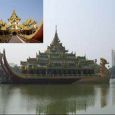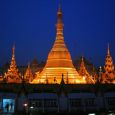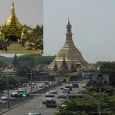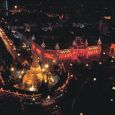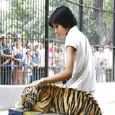Yangon
Advertisement
Yangon Region has the best transportation infrastructure in the country. All transport to and from the rest of the country (and the world) goes through Yangon. Five "highways" link Yangon to the rest of the country.(To be sure, the definition of highway is loosely used. Most highways are no more than two lane roads with pot-hole prone pavement.) Yangon International Airport is the main international gateway of the country. Yangon Central Railway Station is a major hub of the 5,068-kilometre (3,149 mi) Myanmar Railways system. Twante Canal, which links Yangon to Ayeyarwaddy Region, is also widely used for both transport and commerce.
As motor transportation is highly expensive for most people, buses are the main mode of transportation within the division or regions nearby. In January 2008, Yangon Region had nearly 182,000 motor vehicles, 17.7% of the country's total.
Shwedagon pagoda Yangon Myanmar
Myanmar Shwedagon pagoda (paya) has achieved iconic status for Yangon and along with Bagan, for the country as a whole. However, unlike the monuments of those western cities, the majority of the pilgrims visiting Shwedagon are local, it's meaning deeply religious and rather than being a beacon of the modern, it proudly stands for the ancient and timeless. To a foreigner may be the most exotic element of this huge gold bell-shaped temple is how casually it stands amid the modern and familiar, or how Burmese who live literally in its shadow go about their everyday lives without seeming to register amazement or awe in its existence. If Bagan is special in part because of its isolation, Shwedagon seems all the more exotic because of the way it has been domesticated and intertwined in the physical and mental geography of the city. In the heat of the day, the stupa glitters bright gold. When the sun sets it casts its last rays on the soft orange dome, and a swarm of sparrows migrates from the Shwedagon grounds until their return the following morning, it can be quiet and contemplative, or colorful and raucous. Kipling called its golden mystery a beautiful winking wonder. For Myanmar Buddhists, it is the most sacred of all Myanmar Buddhist sites in the country, one which all Burmese hope to visit at least once in their lifetime.
Sule Paya Yangon
Yangon Sule paya is another example of the strange incongruity of the Yangon cityscape. It's not everywhere you check the internet and cist a shrine said to contain a hair of the Buddha in the space of a few blocks. The central stupa's name, kyaik athok, translates in the mon language as the stupa where a sacred hair relic is enshrined, as with many other ancient Myanmar shrine, it has been rebuilt and repaired many times over the centuries, so no one really know exactly when it was built. The golden Zedi is unusual in that its octagonal shape continues right up to the bell and inverted bowl. It stands 46 m high and is surrounded by small shops and all the familiar nonreligious activities that seem to be a part of every zedi in Myanmar. Besides its significance as a landmark and meeting place, maybe its most mundane function is as a milestone from which all addresses to the north are measured.
Botataung Paya Yangon
One of Yangon's big three Pagoda (payas), and said to contain hair relics of the Buddha, the Botataung Pagoda (Paya) was named after the 1000 military leaders who escorted relics of the Buddha to Myanmar from India over 2000 years ago (Bo means leader, usually in a military senses and tataung means 1000). For one six month period this paya is said to have harbored all eight strands of the Buddha's hair before they were distributed elsewhere. Of course it's not breathtaking like Shwedagon or striking for being so out of place like Sule paya, however Batataung's spacious river front location and elements of kitsch make it worth visiting in Yangon Myanmar.
Chaukhtagyi Paya Yangon
Good thing he's resting because when magnified to this size the placid features of the Buddha in repose can start to seem some what eerie, especially if you being to imagine what he would look like standing above you. Monstrous fantasies of the Buddha aside, the reclining Buddha at Chaukhtagyi, almost as large as the enormous figure in Bago, is impressive. Housed in a large metal roofed shed, only a short distance northeast beyond the Shwedagon paya in Yangon, this huge figure is surprisingly little known and hardly publicized at allif you can't get to Bago to see the Shwethalyaung Pagoda, then don't miss this colossal image. Fortune tellers on the surrounding platform offer astrological and palm readings.
Kaba Aye Paya Yangon
Kaba Aye Paya Yangon is the world peace Zedi was built for the 1954-56 sixth Buddhist synod. The 34m high stupa also measures 34 m around its base. It stands about 11 km north of the city centre, a little beyond the renaissance Dusit Inya lake hotel, Yangon. This attempt to construct a modern Pagoda (paya) was not terribly successful it does not have the same visual appeal of Myanmar's older, more graceful Stupa. The interior of the monument, how ever, is hollow and contains some nice Buddhist sculptures, including four sided sculpture ( lei myet hna ) in Myanmar language.
Maha Pasana Guha Yangon
The great cave is a totally artificial one, built close to the Kaba Aye paya. It was here that the sixth Buddhist synod was held in 1954-56 to coincide with the 2500th anniversary of the Buddha's enlightenment. The cavern measures 139m by 113m. This enormous cave, which can accommodate up to 10,000 people, took only 14 months to build; it helps if you have 63,000 laborers. The cave is still used to hold grand religious ceremonies in Yangon, Myanmar.
National Museum Yangon
(phone: 282653, pyay Rd, adult/child/student US$ 5/10/10, 10 am to 4 pm)
National Museum in Yangon Myanmar is about 1km north of Bogyoke Aung San Rd, and just south of the Indonesian embassy is the National Museum, an unspectacular, cavernous and quite sparsely labeled collection. Nevertheless, you can find a number of interesting exhibits, especially the 8m high sihasana(lion throne), which belonged to King Thibaw Min, the last Burmese king. There is also a fair range of royal regalia, much of which was plundered by the British but later returned(in fact you will find a more impressive Burmese collection in Landon's Victoria and Albert Museum). Also worth a look are some extraordinarily intricate examples of 19th century Burmese woodcarving.
Bogyoke Aung San Museum
(phone: 541359, Bogyoke Aung San Museum St; opened 10 am to 3:30 pm)
Bogyoke aung San Museum is the former home of general Aung San and his wife Daw Kin Kyi, and contains remnants of another era in Yangon Myanmar. The house itself dates from the 1920s and the rooms, stairway, railings and furniture are fairly intact. There are several old family photos, which of course include daughter Suu Kyi as a little girl.
Myanmar Gems Museum and Gems market
Yangon Myanmar Gem Museum is just north of Parami Rd, this Gems museum is meant to impress starting with the world's largest sapphire that comes from Mogok to the northeast of Mandalay. The sapphire measures 17 cm in height, and is nearly 12 kg in weight; this somehow translates to 63,000 carats. The Gems museum also boasts the world's largest jade boulder, rough ruby, and star sapphire. Other not so impressive claims include the only mineral with imperial in its name. The Gems Market is spread over three floors. In a currently poor country famous for valuable resources, the museum offers an unintended lesson in beauty, politics and money.
Myanmar Yangon Zoo
(phone: 722134, 6 am to 4 pm)
The monkey pen looks like a concrete cyclorama and the elephants are tethered in place by heavy chins, nevertheless the zoo and connecting 0.7 hectare gardens make popular outing for Myanmar families. The entrance is opposite the Dolphin Seafood restaurant on Kandawgyi Lake. Originally developed in 1906 by the British, the sparsely landscaped grounds include a couple of artificial lakes, a playground and a miniature train circuit for kids, and English and Latin labels.
Kandawgyi Lake Yangon
Occupying prime Yangon real estate, this natural lake close to the city centre is good place for a stroll. Don't expect untamed nature or meditative quiet here as the sidewalk surrounding the circumference of Kandawgyi also runs alongside a busy road. The lake seems at its most attractive at sunset, when the glittering Shwedagon pagoda is reflected in its calm water and you will find the best sunset view from the lake's eastern edge.
Information not available


